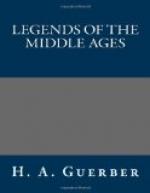[Sidenote: Classical cycle.] A very large class of romances, common to all European nations during the middle ages, has also been purposely omitted from the foregoing pages. This is the so-called “classical cycle,” or the romances based on the Greek and Latin epics, which were very popular during the age of chivalry. They occupy so prominent a place in mediaeval literature, however, that we must bespeak a few moments’ attention to their subjects.
In these classical romances the heroes of antiquity have lost many of their native characteristics, and are generally represented as knight-errants, and made to talk and act as such knights would. Christianity and mythology are jumbled up together in a most peculiar way, and history, chronology, and geography are set at defiance and treated with the same scorn of probabilities.
The classical romances forming this great general cycle are subdivided into several classes or cycles. The interest of the first is mainly centered upon the heroes of Homer and Hesiod. The best-known and most popular of these mediaeval works was the “Roman de Troie,” relating the siege and downfall of Troy.
Based upon post-classical Greek and Latin writings rather than upon the great Homeric epic itself, the story, which had already undergone many changes to suit the ever-varying public taste, was further transformed by the Anglo-Norman trouvere, Benoit de Sainte-More, about 1184. He composed a poem of thirty thousand lines, in which he related not only the siege and downfall of Troy, but also the Argonautic expedition, the wanderings of Ulysses, the story of Aeneas, and many other mythological tales.
This poet, following the custom of the age, naively reproduced the manners, customs, and, in general, the beliefs of the twelfth century. There is plenty of local color in his work, only the color belongs to his own locality, and not to that of the heroes whose adventures he purports to relate. In his work the old classical heroes are transformed into typical mediaeval knights, and heroines such as Helen and Medea, for instance, are portrayed as damsels in distress.
This prevalent custom of viewing the ancients solely from the mediaeval point of view gave rise not only to grotesque pen pictures, but also to a number of paintings, such as Gozzoli’s kidnapping of Helen. In this composition, Paris, in trunk hose, is carrying off the fair Helen pickaback, notwithstanding the evident clamor raised by the assembled court ladies, who are attired in very full skirts and mediaeval headdresses.
On account of these peculiarities, and because the customs, dress, festivities, weapons, manners, landscapes, etc., of the middle ages are so minutely described, these romances have, with much justice, been considered as really original works.




